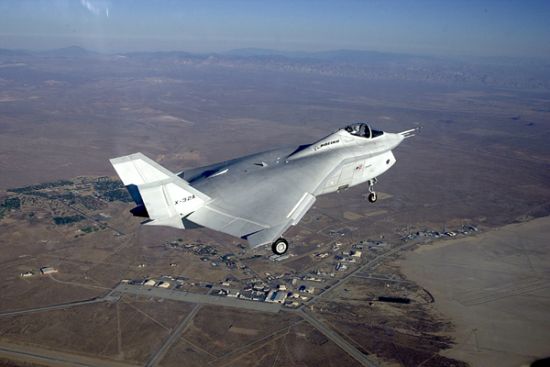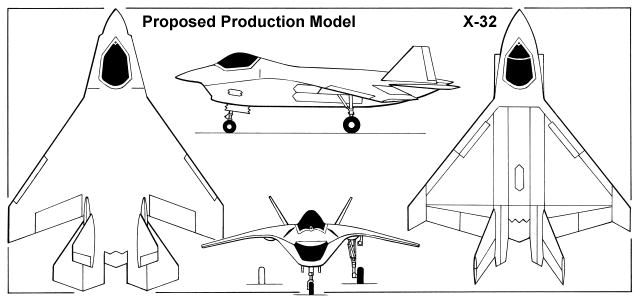|
||||||||||
|
|
||||||||||
|
||||||||||
|
|
||||||||||
 - -
|
|

|
Boeing X-32 Fighter Demonstrator |
|
DESCRIPTION:
When the concept demonstrator phase of the Joint Strike Fighter competition was announced in 1996, Boeing was awarded a contract to construct and flight test two X-32 demonstrators of its fighter design. Boeing adopted a rather compact layout featuring a trapezoidal wing of high surface area mounted high on a rather portly fuselage. The X-32 was powered by a single advanced turbofan engine fed by one large intake under the cockpit. A unique aspect of Boeing's original inlet design was its ability to move forward and downward to open an auxiliary intake slot bringing in more air for flight at very low speeds (such as landing aboard an aircraft carrier on the Navy variant). As with the competing Lockheed Martin X-35, Boeing designed three variants of the X-32 for evaluation. The conventional takeoff and landing (CTOL) X-32A was developed for the US Air Force, the short takeoff and vertical landing (STOVL) X-32B for the US Marine Corps and UK Royal Navy, and the carrier-based (CV) X-32C for the US Navy. However, only two flying examples were actually built. The first to fly, the X-32A, was used to demonstrate overall flight characteristics, systems, and control software. This model was also used to evaluate the low-speed handling and carrier-approach qualities of the X-32C naval variant. The second example, the X-32B, was equipped with a direct lift system for STOVL operations and was used primarily to evaluate vertical flight and hover characteristics. Boeing's strategy for STOVL flight was based on that used in the British Harrier. The single engine was mounted at the center of the vehicle and its thrust directed through three movable nozzles permitting vertical flight. Boeing preferred this approach to Lockheed's lift fan design citing it as less risky. Nevertheless, this hover method was ultimately viewed as a limitation of the X-32 design. Boeing was also penalized for proposing several changes between the X-32 demonstrator and the final production model. Among these changes was abandonment of the variable intake cowl designed for the X-32C, replacement of the twin tails on the X-32 with more conventional vertical and horizontal tails, and a redesigned wing (see the 3-view below). These factors caused Boeing to lose the JSF contract during the October 2001 downselect, and Lockheed Martin was instead chosen to build a production F-35.
Data below for X-32A |
|
| HISTORY: | |
| First Flight |
(X-32A) 18 September 2000 (X-32B) 29 March 2001 |
|
Service Entry
|
did not enter service
|
| CREW: |
one: pilot
|
|
ESTIMATED COST:
|
(X-35A) $28 million [1994$] (X-35B) $35 million [1994$] (X-35C) $38 million [1994$] |
| AIRFOIL SECTIONS: | |
| Wing Root | unknown |
|
Wing Tip
|
unknown
|
| DIMENSIONS: | |
| Length |
(X-32A) 47.42 ft (14.47 m) (X-32B) 46.00 ft (14.03 m) |
| Wingspan |
(X-32A) 36.00 ft (11.00 m) (X-32B) 30.00 ft (9.15 m) |
| Height | 13.33 ft (4.07 m) |
| Wing Area |
(X-32) 590 ft² (55 m²) (production) 540 ft² (50 m²) |
|
Canard Area
|
not applicable
|
| WEIGHTS: | |
| Empty |
(X-32A) 22,500 lb (10,205 kg) (X-32C) 24,500 lb (11,115 kg) |
| Normal Takeoff | (X-32A) 38,000 lb (17,235 kg) |
| Max Takeoff |
(X-32A) 50,000 lb (22,680 kg) (X-32C) 60,000 lb (27,215 kg) |
| Fuel Capacity |
(X-32A) 15,000 lb (6,805 kg) [internal] (X-32C) 17,000 lb (7,710 kg) [internal] |
|
Max Payload
|
(X-32A) 14,000 lb (6,350 kg) (X-32B) 14,000 lb (6,350 kg) (X-32C) 18,000 lb (8,165 kg) |
| PROPULSION: | |
| Powerplant | (X-32A) one Pratt & Whitney F119-614C turbofan |
| Thrust |
35,000 lb (155 kN)
|
| PERFORMANCE: | |
| Max Level Speed |
at altitude: Mach 1.5 at sea level: unknown |
| Initial Climb Rate | unknown |
| Service Ceiling | unknown |
| Range |
(X-32A) 1,700 nm (3,150 km) (X-32B) 1,200 nm (2,160 km) (X-32C) 1,500 nm (2,700 km) |
| Endurance | unknown |
| g-Limits |
unknown
|
| KNOWN VARIANTS: | |
| X-32A | Multi-role conventional takeoff (CTOL) demonstrator for the US Air Force; 1 built |
| X-32B | Multi-role short takeoff and vertical landing (STOVL) demonstrator for the US Marine Corps and UK Royal Navy; 1 built |
| X-32C |
Navalized (CV) demonstrator similar to the X-32A but with larger fuel tanks and increased takeoff weight;
none built during the X-32 evaluation, but the X-32A was used for 33 carrier approach test flights
|
|
KNOWN OPERATORS:
|
United Kingdom (Royal Navy) United States (US Air Force) United States (US Marine Corps) United States (US Navy) |
|
3-VIEW SCHEMATIC:

|
|
SOURCES:
|
|


|
Aircraft | Design | Ask Us | Shop | Search |

|
|
| About Us | Contact Us | Copyright © 1997-2023 | |||
|
|
|||